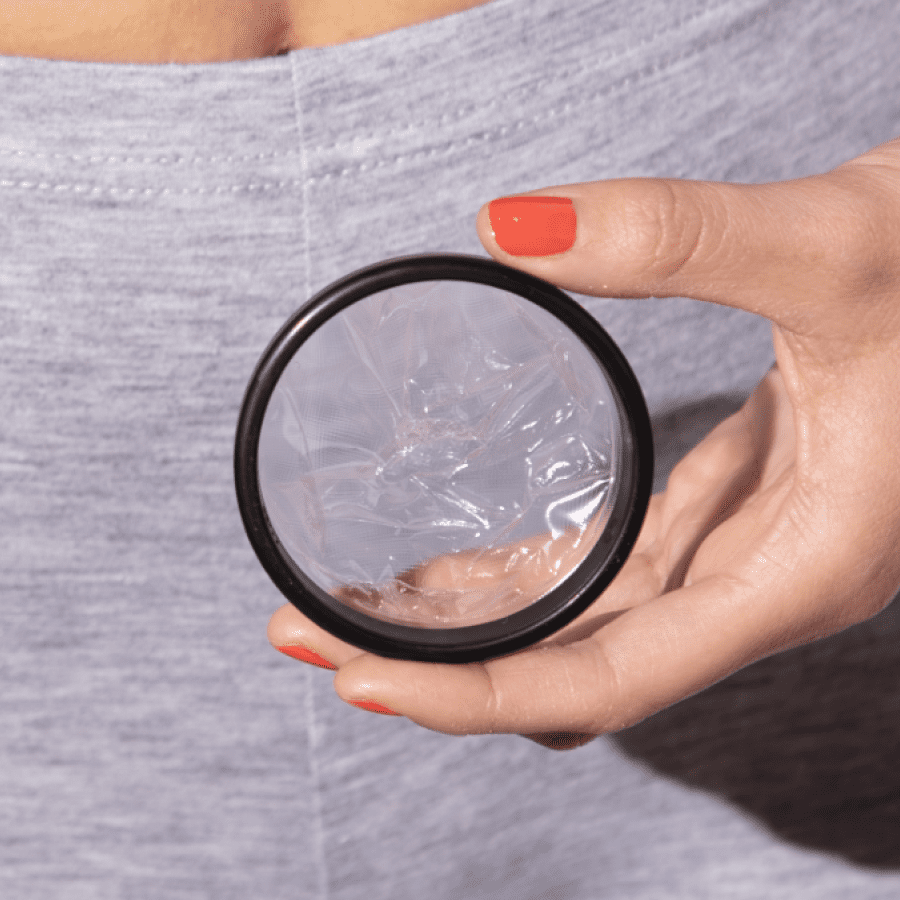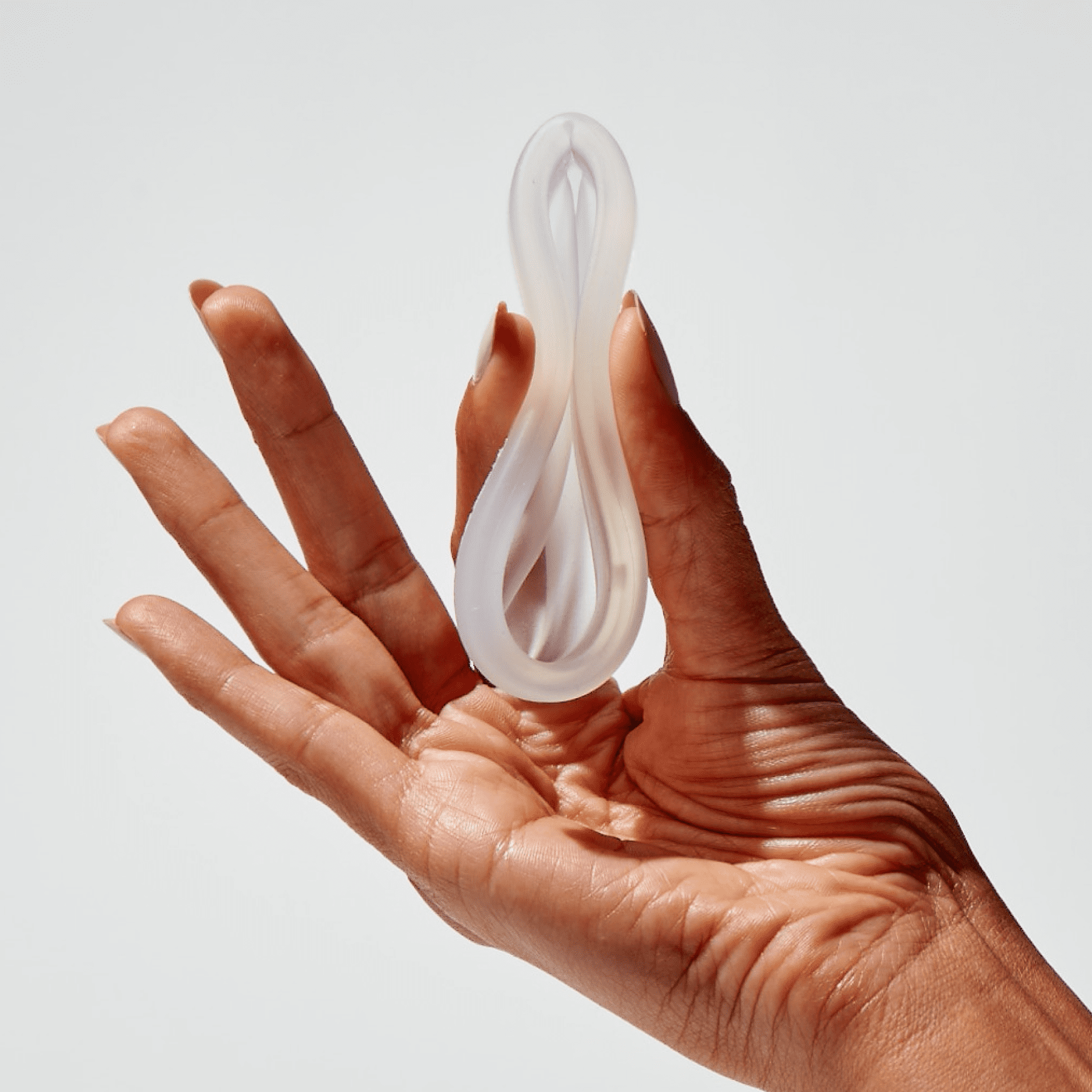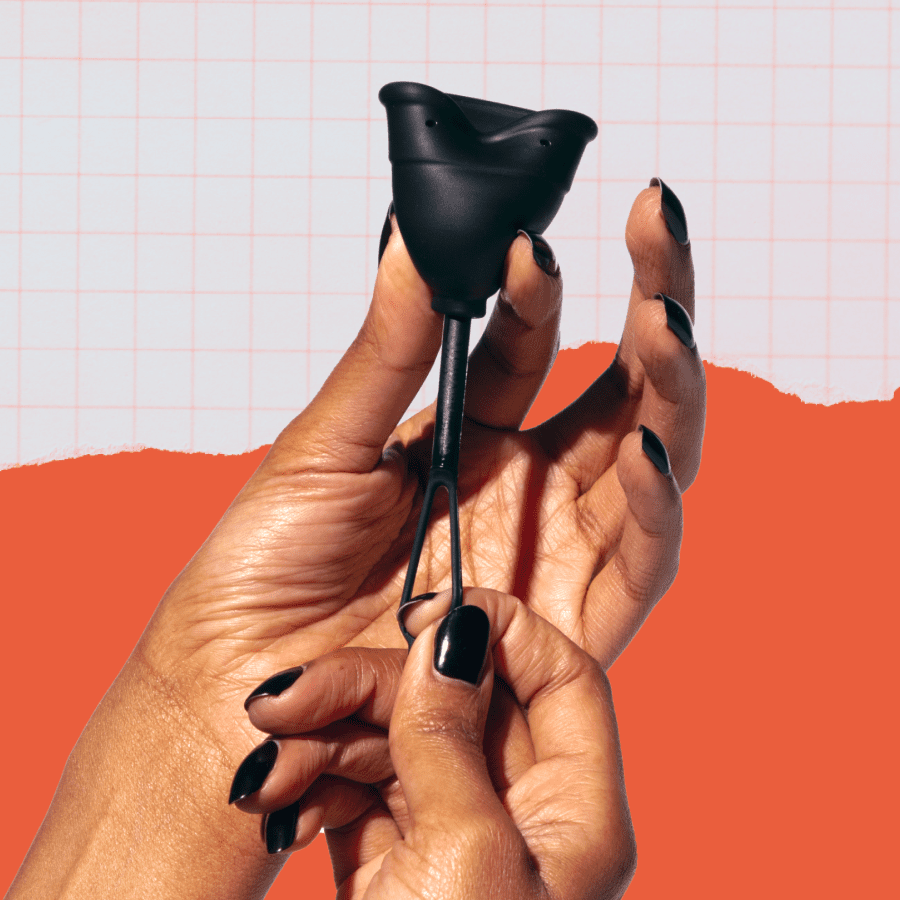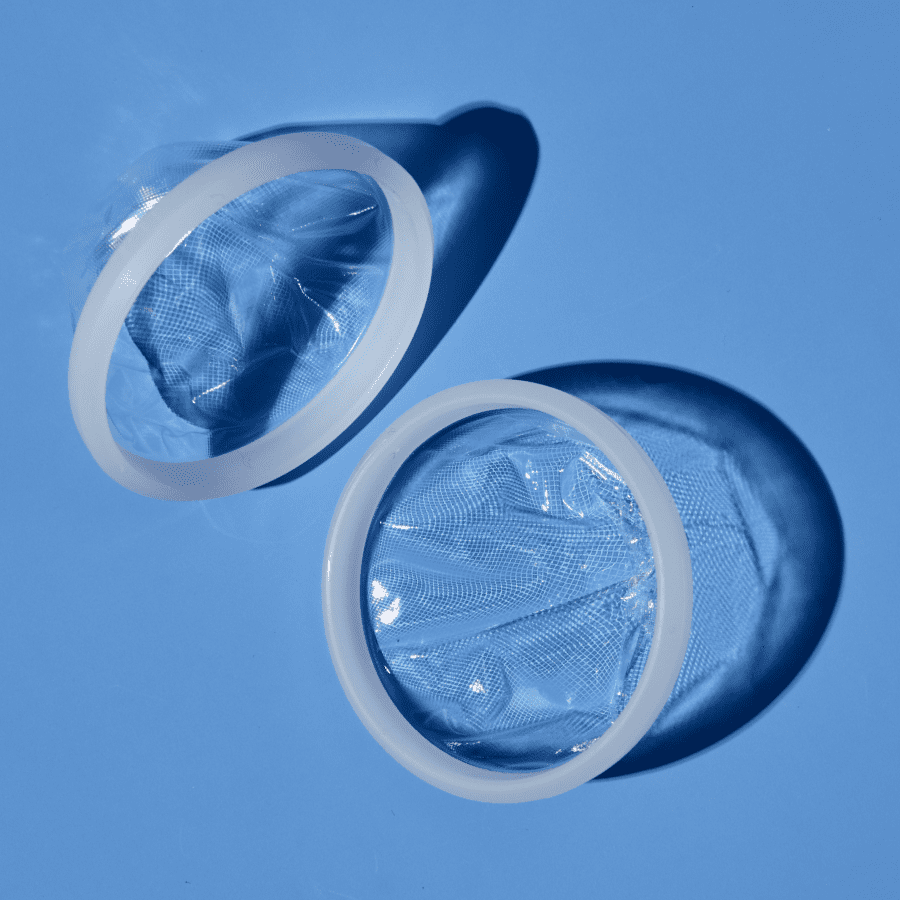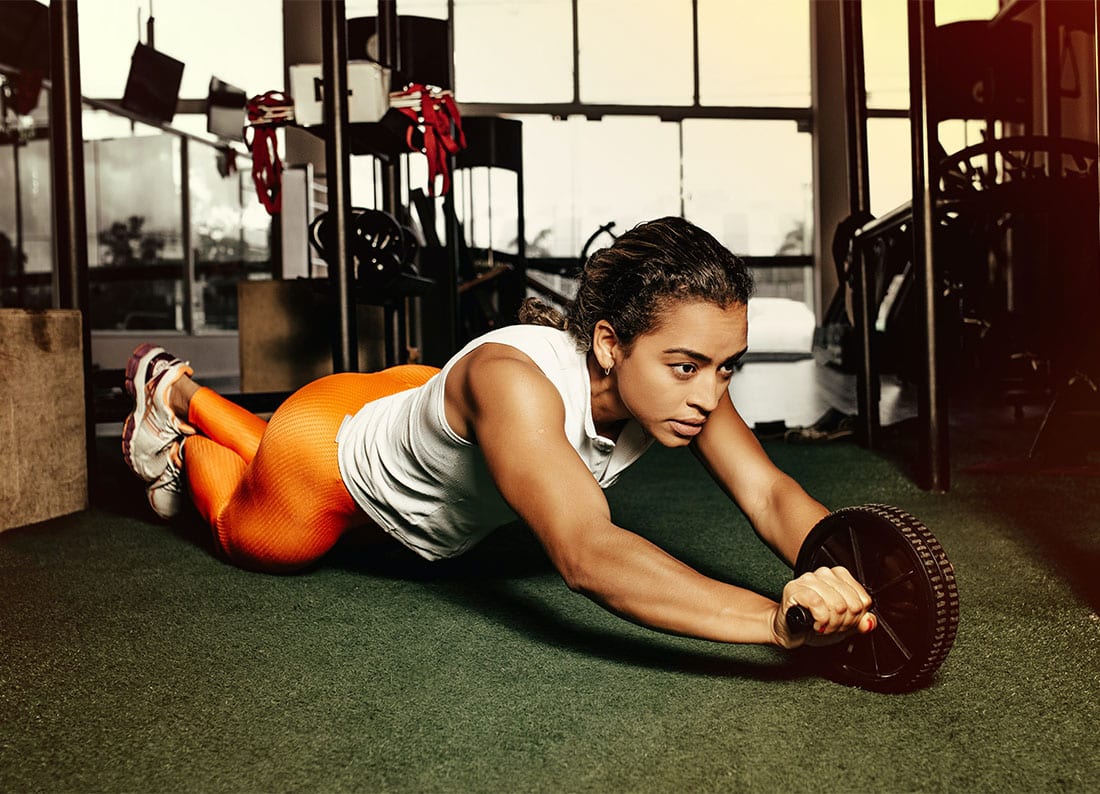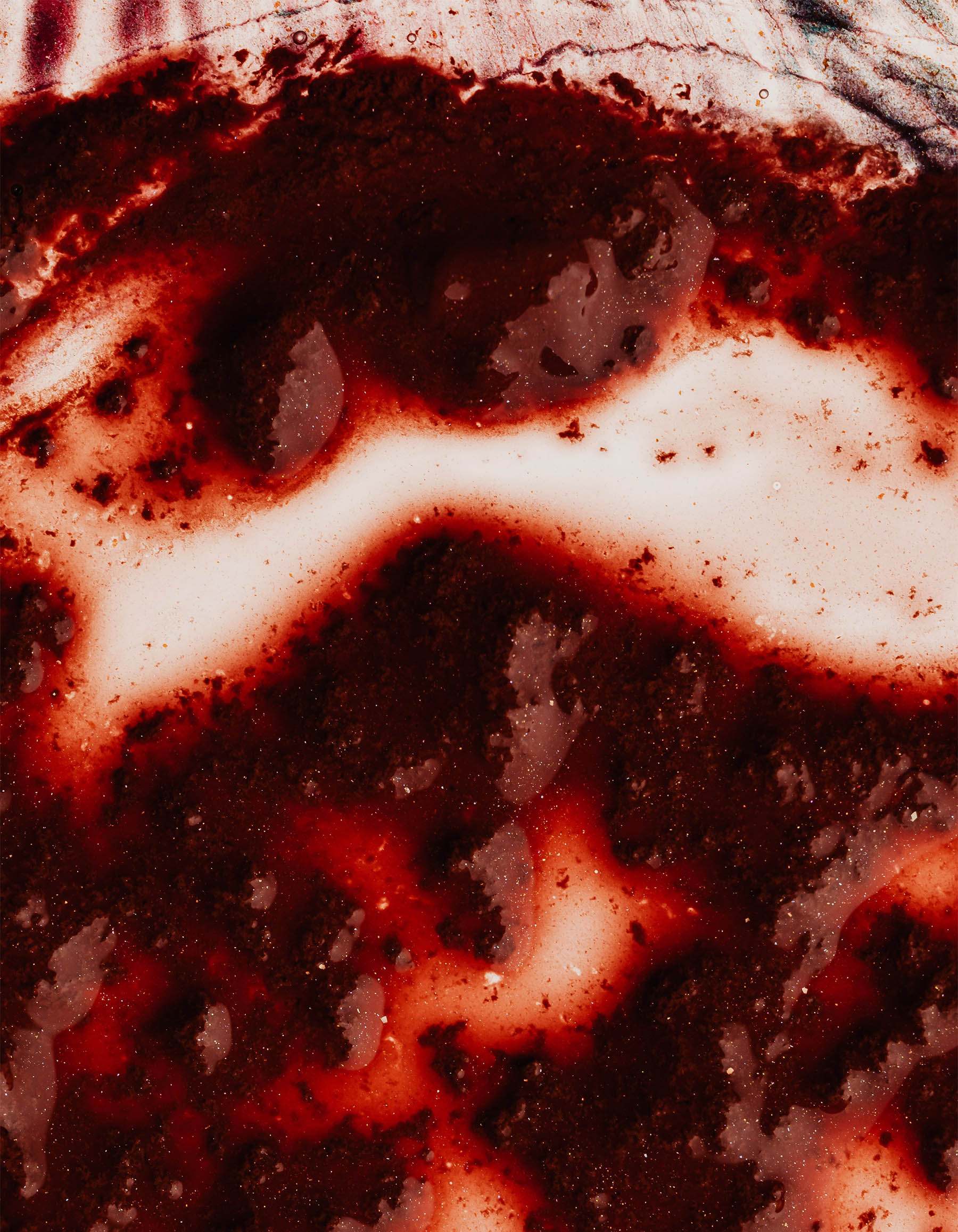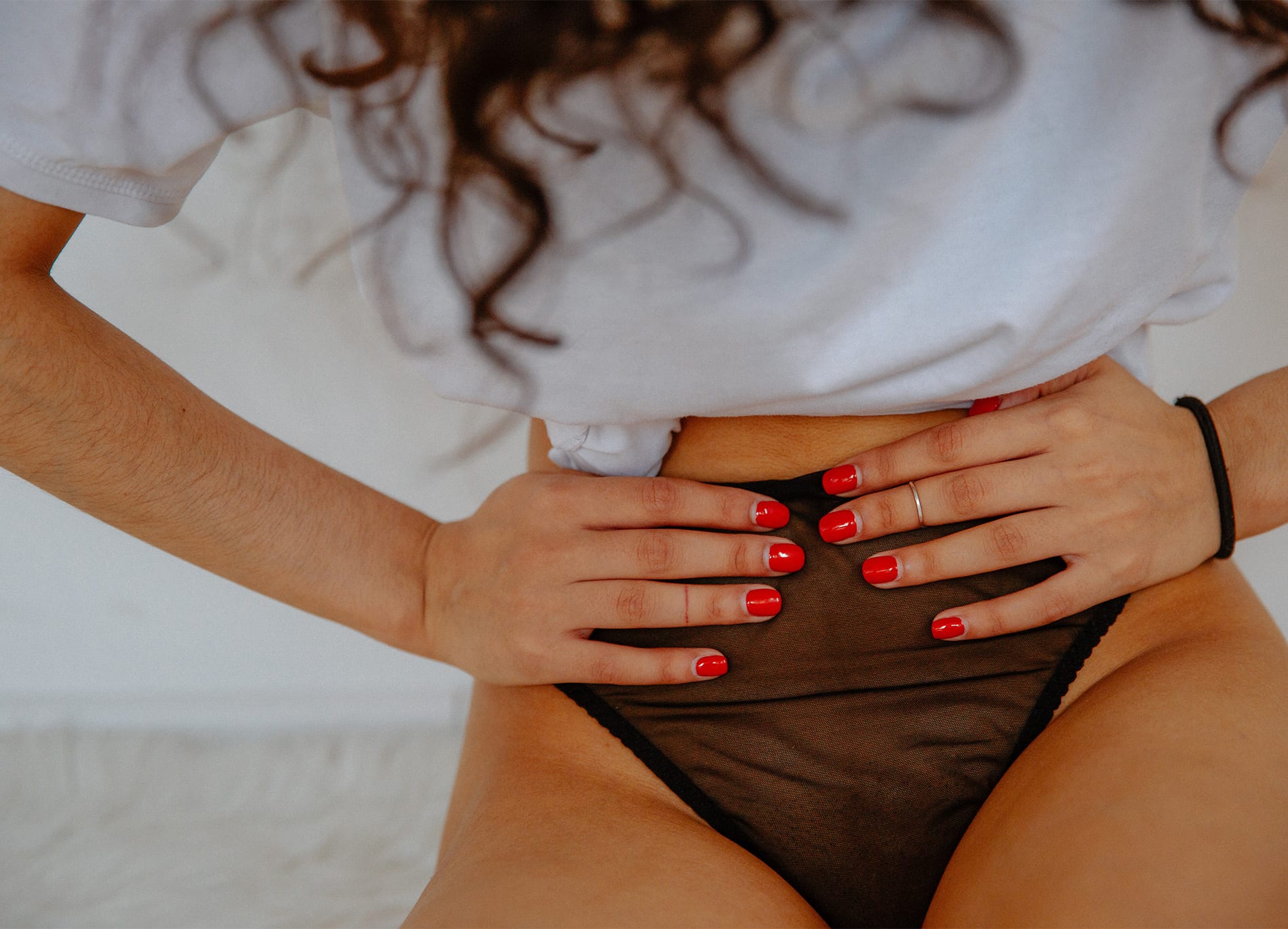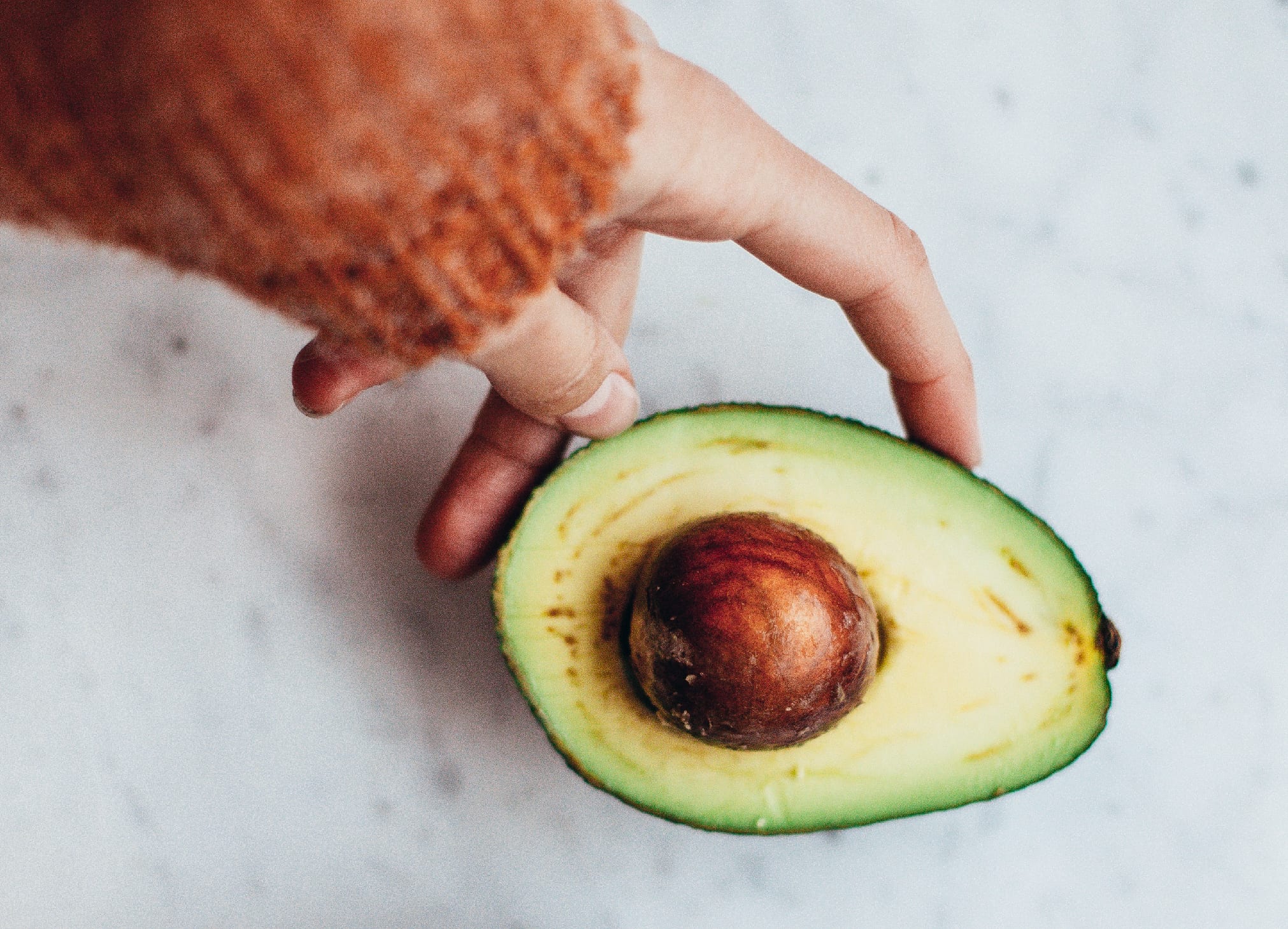6 weird but effective ways to deal with your worst PMS symptoms
Tips & hacks for fighting period pain & discomfort
TL/DR: While we’ve traditionally relied on heating pads and ibuprofen to relieve PMS symptoms, these six weird but effective methods might make your period even less aggravating: Try switching to a hormone-balancing diet. Incorporate low-impact exercise into your daily routine. Book an acupuncture appointment, visit your local dispensary, or add some aromatherapy oils to your shopping cart.
Most people with periods are well acquainted with PMS (a.k.a. premenstrual syndrome). It’s that monthly onslaught of emotional and physical discomfort that comes busting through the door a few days before we bleed, usually hitting heavy with its trademark: uterine cramps.1 And sometimes the good ole heating pad and ibuprofen just don’t hit the spot like they used to.
Maybe you’ve gone down the Goop rabbit hole, promising yourself that this time you really will add more greens and natural supplements to your diet. Maybe you’ve made a New Year’s resolution to find healthier alternatives to treat your aches and pains, including PMS symptoms. Whatever your reason may be, we’re with you. So, in the spirit of taking less Advil, here are six weird but effective ways to deal with your worst PMS symptoms:
PMS Hack #1: Switch to a hormone-balancing diet
Some holistic practitioners and dieticians have found that we can manage PMS symptoms by tailoring our diets to the four phases of the menstrual cycle: menstruation, the follicular phase, ovulation, and the luteal phase. While we know that diet is far from the only factor that can influence the menstrual cycle, it certainly has an impact.
During the luteal phase, for example (the phase leading up to your period), carbonated drinks, caffeine, artificial sweeteners, red meat, dairy, added salt, and alcohol are foods that may trigger discomfort or make cramps worse.2 We won’t go into detail here as to exactly why each of these foods may create additional discomfort, but if you’re looking for a few healthy alternatives, check out these five recipes for before or during your period.
If you’re going to stay away from one food group, though, we’d suggest avoiding red meat and processed, packaged foods (sorry, Lunchables!). Why? The extra estrogen contained in some of these food and animal products can make cramps worse. Estrogen that occurs naturally in the body (a.k.a. endogenous estrogen) thickens the uterine lining in preparation for pregnancy. When the body realizes that it isn’t pregnant, the cells break down and release inflammatory prostaglandins — the pesky chemical compounds that cause menstrual cramps.3
Exogenous estrogens, on the other hand, are synthetic forms of estrogen that are introduced into the body through an external source (like hormonal birth control). Red meat and certain processed foods may contain exogenous estrogen that originates from synthetic fertilizers and pesticides.4
So, imagine trying to sweep your kitchen floor while someone else continues to drop crumbs: Exogenous estrogens confuse the body during the luteal phase, creating more resistance as the uterine lining prepares to shed.
Carbonated drinks, artificial sweeteners, and alcohol can also increase inflammation and aggravate those prostaglandins, prolonging your cramps.4 Your body deserves the best, whether or not you’re on your period. Each person’s digestive system can react to carbonated drinks, processed foods, and red meat very differently. Even if you’re skeptical of switching to a hormone-balancing diet, it couldn’t hurt to add a few healthier selections every now and then.
PMS Hack #2: Try acupuncture
Those with a fear of needles might shy away from this ancient form of medicine – but here’s why you might want to give it a shot:
According to Dr. Jasna Cerkez Habek and her team of researchers at the Ministry of Health in Croatia, acupuncture may significantly reduce symptoms of PMS and even PMDD, though the effects may only last a short amount of time. One study found that acupuncture had a success rate of 77.8% in treating PMS symptoms compared to 5.95% in a placebo group that was treated with medications like progestin (a synthetic hormone) and fluoxetine, two medications prescribed to treat PMS symptoms.5 6
Other studies suggest that, because acupuncture is a holistic health practice that requires repetitive treatments, it’s difficult to perform accurate scientific research about its effects in general.5 7 There are many sides to every argument, but the most important thing to consider is your own comfort level.
Do you get queasy around needles? Are you a non-believer going into the experience with a negative outlook? Sometimes our mindset around a nontraditional practice can affect how we experience it. Plus, this treatment option may not always be accessible. Some insurance policies don’t cover it and treatment can cost anywhere between $75-250 per session, depending on who you see.
But if you’re curious to see if it works, there’s no harm in trying. A few things to expect:
- Acupuncturists might ask more questions than you’re used to during other doctor’s visits. They might ask you about digestive issues, stress, coping skills, and even unresolved trauma. Acupuncture is rooted in the Chinese study of balancing qi (pronounced “chi”), or energy. Gaining a holistic perspective on your overall health can help your acupuncturist better serve your needs.
- Eat a light meal two hours before your appointment and drink plenty of water. Some people report feeling lightheaded after finishing their treatment. It’s best not to go into acupuncture on an empty stomach.
- You can keep your clothes on. Acupuncture is different from massage therapy in this regard. Sometimes, your acupuncturist might ask you to wear a medical gown, but for the most part, the body stays covered. That being said, try to wear loose-fitting clothes to make it easier for your acupuncturist to place the needles.
- The needles are really small and relatively painless. Let’s get technical: needle sizes are measured in gauges. The higher the gauge, the smaller the needle. Syringe needles are typically between 25 and 27 gauges, while acupuncture needles range from 30 to 40 gauges. These needles are so much thinner than the ones that prick us for our flu shots. Some report that they don’t even feel them at all.8
Again, the golden rule is to listen to your body. If you’re unsure whether or not acupuncture is right for you, talk to your doctor about the possible effects and benefits, especially when it comes to treating your worst PMS symptoms.
PMS Hack #3: Sneak in some more exercise
When your period comes, it’s normal to want to stay snuggled up in bed all day. But some studies show that getting exercise can actually relieve menstrual pain – even if it’s the last thing you feel like doing.
Here’s why: During exercise, the body releases endorphins – and endorphins have a pretty magical (and scientifically proven) pain-reducing, mood-boosting quality. Exercise will also help to reduce the bloating that tends to come along with period cramps and fatigue.9 Start by choosing less intense aerobic workouts if you’re feeling a lot of pain. Try going for a quick walk, jog, or bike ride, or do some gentle stretching
When practiced correctly, certain yoga poses and flows can also decrease stress and relieve PMS symptoms.10 Just be mindful about trying poses that are too advanced or feel too difficult for your body at the moment.
If you’re tuning in to a virtual yoga class, double-check the screen to make sure you’re doing the poses correctly. Pushing your body too hard or practicing incorrectly could actually do more damage and intensify the pain.11 Keep it simple with cat-cow and bridge pose, which can relieve the pressure put on the abdominal muscles and lower back while you’re PMSing.
PMS Hack #4: Try a homeopathic supplement
Women and individuals AFABAFAB stands for “assigned female at birth.” (assigned female at birth) spend billions of dollars on homeopathic supplements and remedies each year. Of these consumers, a significant number (4%) are trying to relieve menstrual cramps.
Those who stay away from ibuprofen or other over-the-counter meds may try supplements like calcium, magnesium, or vitamin B6 L-tryptophan, which some studies have shown are effective in reducing PMS symptoms.12 Another study shows that a 500mg daily dose of calcium effectively improved depression, anxiety, bloating, and emotional symptoms related to PMS.13
There’s also some science that supports ginger (a root you can buy fresh at your local grocery store) and zinc sulfate (a naturally occurring mineral) as possible treatments for primary dysmenorrhea (another word for painful periods).
According to the researchers who conducted the 2014 study, “Compared with the placebo receiving group, participants receiving ginger and zinc sulfate reported more alleviation of pain during the intervention. Ginger and zinc sulfate had similar positive effects on the improvement of primary dysmenorrheal pain in young women.” 14
While there are many potential benefits to taking vitamins, herbs, and other supplements, it’s important to talk to your doctor before getting started. Even homeopathic supplements and remedies have the potential to interact dangerously with other medications – and, in addition, some supplements could do more harm than good if you’re already getting enough of the nutrient from your diet alone.
PMS Hack #5: CBD FTW?
Most of us know a friend or two who rely on cannabis (if weed is legal in your state, of course) to soothe menstrual pain. But does it really work?
The science points to yes. There are two popular chemicals that are harvested from the cannabis plant: THC and CBD. THC, or tetrahydrocannabinol, is a chemical with psychoactive effects. Sure, our brains might go straight to Pineapple Express, but THC also has medicinal properties that can reduce inflammation, relieve nausea, and even fight cancer.15
THC is only legal for recreational use in a handful of states, but folks who have a medical card can access it in most states. A medical cannabis card is granted to people who struggle with chronic pain, neurodegenerative diseases, and issues with mental health. A doctor might prescribe medical-grade cannabis to people who are concerned about the addictive side effects of narcotic pain medication.16
CBD, or cannabidiol, on the other hand, shares some of the same anti-inflammatory properties as THC, but it is legal in all 50 states. Unlike THC, CBD doesn’t contain the same psychoactive properties that make people all loopy and funny when they smoke weed. A few studies show that cannabis treatments, including CBD oils, edibles, tinctures, and topicals, can relieve symptoms of PMS and PMDD.17
While many of our friends can attest to the powers of the good green via word-of-mouth, we’re still lacking in long-term research to back up these conclusions. There’s a shortage of studies on THC, CBD, and pain relief, and very few that touch on its potential effectiveness in treating PMS and PMDD. If it’s legal in your state, consider giving THC a chance. If not, CBD is a more accessible option – but talk to your doctor first before trying either.
PMS Hack #6: Aromatherapy
Who knew that you could improve your menstrual cramps just by improving the scents in your home?
In one study, participants were asked to inhale lavender oil for five sessions during each cycle. Scientists observed that PMS symptoms like anxiety, depression, nervousness, pain, and bloating were significantly reduced after lavender aromatherapy.18 Clary sage oil also provides therapeutic benefits that affect the autonomic nervous system — the nerves that regulate unconscious bodily functions like breathing, digestion, and heart rate.19
Pair your favorite essential oils with a breathing technique called “4-7-8 breath.” Pick a comfortable position in your room to sit and close your eyes for a minute or two. Take a deep breath through the nose and count to four. Hold the breath and count to seven. Release the breath slowly, exhaling for eight counts. Repeat as many times as you need.
Even when you’re not on your period, aromatherapy can enhance your R&R practices altogether, which can lead to better immune functioning and less stress.
Whatever floats your boat
It’s never too late to find new tips and tricks to add to your PMS Survival Toolkit. Whether we’ve inspired you to take a winter jog, confront your fear of needles, or add some essential oils to your Amazon order, it’s been a delight to help you find new ways to boost your wellness while managing PMS symptoms.
If it’s the hassle of changing your period product ALL THE TIME on your heavy days or the friction-y, crampy discomfort caused by tampons that bothers you the most, well, allow us to introduce a couple of products that (in our humble opinion) are game-changers: Flex Disc™ and Flex Cup™. Hit those links to learn more about the disc and cup and their cramp-reducing magic.
One final note: If you’re experiencing PMS or period pain that’s much more severe than usual, do make sure to talk to your doctor. When in doubt, it’s always best to consult the professionals!
Know of any other PMS hacks, tips, or tricks that we should share with our readers? Feel free to send us a message at thefornix@flexfits.com.
This article is informational only and is not offered as medical advice, nor does it substitute for a consultation with your physician. If you have any gynecological/medical concerns or conditions, please consult your physician.
© 2021 The Flex Company. All Rights Reserved.
- Dickerson, L. M., Mazyck, P. J., & Hunter, M. H. (2003). Premenstrual syndrome. American Family Physician, 67(8), 1743–1752.[↩]
- Krupp, A. (2020, February 23). What is cycle syncing? Healthline. https://healthline.com/health/womens-health/guide-to-cycle-syncing-how-to-start[↩]
- Harel, Z. (2002). A contemporary approach to dysmenorrhea in adolescents. Pediatric Drugs, 4(12), 797-805. https://doi.org/10.2165/00128072-200204120-00004[↩]
- Mayo, J. L. (1997). Premenstrual syndrome: a natural approach to management. Applied Nutritional Science Reports, 5(6). https://poliklinika-harni.hr/images/uploads/128/pms-priorodne-metode-lijecenja.pdf[↩][↩]
- Habek, D., Habek, J. &., & Barbir, A. (2002). Using acupuncture to treat premenstrual syndrome. Archives of Gynecology and Obstetrics, 267(1), 23-26. https://doi.org/10.1007/s00404-001-0270-7[↩][↩]
- Zhang, J., Cao, L., Wang, Y., Jin, Y., Xiao, X., & Zhang, Q. (2019). Acupuncture for Premenstrual Syndrome at Different Intervention Time: A Systemic Review and Meta-Analysis. Evidence-Based Complementary and Alternative Medicine: eCAM, 2019, 6246285. https://doi.org/10.1155/2019/6246285[↩]
- Cho, S., & Kim, J. (2010). Efficacy of acupuncture in management of premenstrual syndrome: A systematic review. Complementary Therapies in Medicine, 18(2), 104-111. https://doi.org/10.1016/j.ctim.2009.12.001[↩]
- Unified Practice. (2019, August 27). 8 things to expect from your first acupuncture experience. https://www.unifiedpractice.com/first-time-acupuncture-what-to-expect/[↩]
- Mohebbi Dehnavi, Z., Jafarnejad, F., & Sadeghi Goghary, S. (2018). The effect of 8 weeks aerobic exercise on severity of physical symptoms of premenstrual syndrome: A clinical trial study. BMC Women’s Health, 18(1). https://doi.org/10.1186/s12905-018-0565-5[↩]
- Yang, N., & Kim, S. (2016). Effects of a yoga program on menstrual cramps and menstrual distress in undergraduate students with primary dysmenorrhea: A single-blind, randomized controlled trial. The Journal of Alternative and Complementary Medicine, 22(9), 732-738. https://doi.org/10.1089/acm.2016.0058[↩]
- Krucoff, C. (2007, August 28). Insight from injury. Yoga Journal. https://yogajournal.com/practice/insight-from-injury/[↩]
- Rapkin, A. (2003). A review of treatment of premenstrual syndrome & premenstrual dysphoric disorder. Psychoneuroendocrinology, 28, 39-53. https://doi.org/10.1016/s0306-4530(03)00096-9[↩]
- Shobeiri, F., Araste, F. E., Ebrahimi, R., Jenabi, E., & Nazari, M. (2017). Effect of calcium on premenstrual syndrome: A double-blind randomized clinical trial. Obstetrics & Gynecology Science, 60(1), 100–105. https://doi.org/10.5468/ogs.2017.60.1.100[↩]
- Kashefi, F., Khajehei, M., Tabatabaeichehr, M., Alavinia, M., & Asili, J. (2014). Comparison of the effect of ginger and zinc sulfate on primary dysmenorrhea: A placebo-controlled randomized trial. Pain Management Nursing, 15(4), 826-833. https://doi.org/10.1016/j.pmn.2013.09.001[↩]
- Grotenhermen, F., & Müller-Vahl, K. (2016). Medicinal uses of marijuana and cannabinoids. Critical Reviews in Plant Sciences, 35(5-6), 378-405. https://doi.org/10.1080/07352689.2016.1265360[↩]
- Leafly. (2020, September 25). The ultimate guide to medical marijuana in the US. https://www.leafly.com/learn/legalization/medical-states[↩]
- Slavin, M., Barach, E., Farmer, S., Luba, R., & Earleywine, M. (2017). Cannabis and symptoms of PMS and PMDD. Addiction Research & Theory, 25(5), 383-389. https://doi.org/10.1080/16066359.2017.1294165[↩]
- Uzunçakmak, T., & Ayaz Alkaya, S. (2018). Effect of aromatherapy on coping with premenstrual syndrome: A randomized controlled trial. Complementary Therapies in Medicine, 36, 63-67. https://doi.org/10.1016/j.ctim.2017.11.022[↩]
- Geethanjali, S., Venugopal, V., Poonguzhali, S., & Maheshkumar, K. (2020). Effect of clary sage oil as an aromatherapy on cardiac autonomic function among patients with premenstrual syndrome – A randomized controlled study. Obesity Medicine, 18, 100193. https://doi.org/10.1016/j.obmed.2020.100193[↩]

